 |
| Meet Marlina. Nemo's Dad? |
What Disney isn't telling you: The story of Nemo from a scientific point of view!
Kaitlin Johnson
First off, clown fish are a unique species of fish
that are capable of sequential hermaphroditism, which basically means they
possess the ability to change sex. Sequential hermaphroditism can happen in one
of two ways: either a fish can change from a female to a male (protogyny), or
from male to a female (protandry). Still yet, other fishes can be both sexes at one time, which is termed simultaneous
hermaphroditism.
You may now be asking yourself: why would a fish ever want to change sex?
The answer to this question lies within what has become known as the
size-advantage model. This model was first proposed by Ghiselin in 1969, and
claims that depending upon size it can sometimes be advantageous for an
organism to change sex in order to increase its success rates. In
protandrous fishes like Nemo, some males turn into females when they reach a
larger size because they can then carry more eggs and produce more offspring. In protogynous fish, such as wrasses
and parrotfishes, it is more advantageous for the the larger females to convert
to males, because in these species one large male will control a harem
of females, and being a larger size helps in controlling more smaller females.
So
now that we have the WHY, the next logical question would be HOW?
 |
| Pathways involved in the sex change process in fish |
It is a complicated process and scientists still debate the finer details of how it works. However, the basic underlying
mechanisms can be described as follows: environmental and social cues, such as
when the large female in a school of clown fish dies, are interpreted in the
brain through a combination of olfaction, visual, and sound cues. The brain
then sends a signal to the hypothalamus to synthesize and release
gonadotropin-releasing hormone (GnRH). The GnRH acts as a signal for the
pituitary gland to produce luteinizing-hormone (LH) and follicle stimulating
hormone (FSH). These hormones are released into the blood stream, where
they are able to travel to the gonads and trigger the beginning of a gonadal conversion.
This change in reproductive organs is also associated with behavioral changes. It has been noted in field studies that the behavioral changes sometimes even come before the gonadal changes. One study found that when the large male wrasse (L. dimidiatus) is removed from its harem the largest female will begin to act as the new harem-master within a few hours, but it will take around 10 days until it can start producing sperm.
So when is this fish considered to be fully male? Is it when he obtains social male dominance? Or when his new sperm producing gonads are mature? In a novel study done by John Godwin of North Carolina State University claims the former. In his study, he surgically removed the ovaries from the larger females in a group of wrasses. He then removed the dominant males and waited to see if these larger females would begin to behave as males despite their lack of any reproductive organs. Results showed that even though they possessed no gonads, they socially changed their behavior to be more male oriented, showing characteristics of territorial defense and courtship. In conclusion, these fish were able to fully embrace the male behavioral phenotype while not possessing any testes!
Back to Nemo!
Now with this plethora of knowledge about sequential hermaphroditism in fish, can you come to any conclusions about how Disney's story of Nemo may have been different if it stayed true to science?
Drum roll please. . .
After the loss of Nemo's mother, the most likely scenario was that Nemo's father would have become the new dominant female, and possibly even mated with Nemo. However, this story is probably not quite as suitable for children as the one Disney spun!
Bonus Question: Why did Marlin ask Nemo to brush with the anemone?
How may or may not that help him when it comes to getting stung?
On a side note!
While the fish I talked about in this blog were willingly changing their sex in order to increase their fitness levels and produce as much offspring as possible, I find it worthy to note that other fish are also undergoing similar sex changes, but not for reasons of increased success. Rather, these fish are being subjected to pollutants released from waste water plants, which contain endocrine disrupters such as nonylphenols and birth control hormones that are seriously altering these fishes' reproductive organs.
 |
| Pathways of endocrine disruptors that could ultimately lead to undesired sex changes in fish |
Take home Message
Be conscientious of what you are putting into the environment, and always take into consideration the effects it may cause.
&
GO WATCH NEMO!
References
Ghiselin, M.T. 1969. The evolution of hermaphroditism among animals. Quarterly Review Biology. 44:189-208.
Godwin, J., D. Crews, and R. R. Warner. 1996. Sex change in the absence of gonads in a coral reef fish. The Royal Society. 263: 1683-1688.
Robertson, D.R. 1972. Social control of sex reversal in a coral reef fish. Science 1977: 1007- 1009.
Warner, R.R. 1975. The adaptive significance of sequential hermaphroditism in animals. The American Naturalist 109: 61-82.
Image/video references
http://media.wiley.com/mrw_images/els/articles/a0021911/image_n/nfg003.gif
http://www.youtube.com/watch?v=eWXOurnVTYg
No comments:
Post a Comment